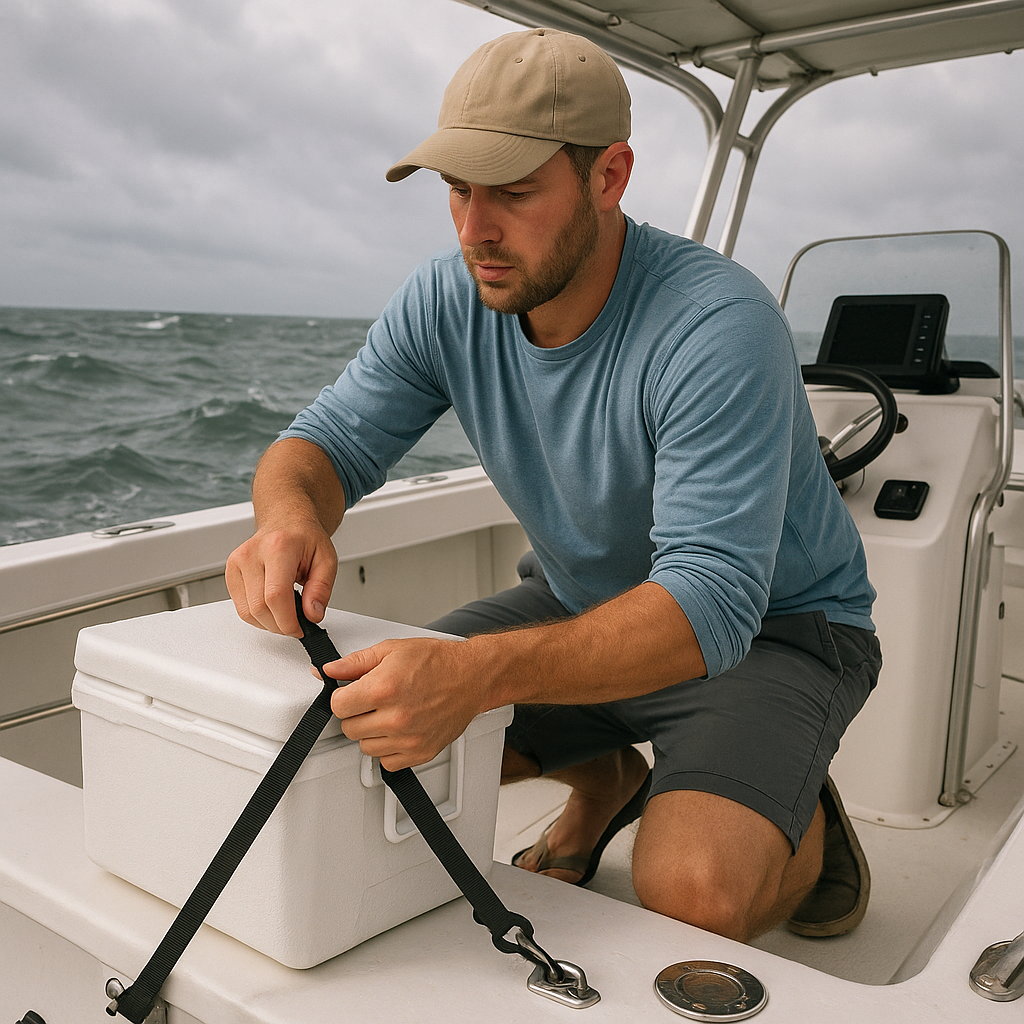Rough water doesn't wait for perfect preparation. When waves start building and chop kicks up, every unsecured item becomes a potential projectile or overboard casualty. The difference between a challenging day on the water and a dangerous one often comes down to what you did before leaving the dock.

The Hidden Cost of Loose Gear
Most boaters underestimate just how violent moderate chop can be. A 2-foot wave might not sound intimidating, but it can generate enough force to turn a loose cooler into a battering ram or send expensive electronics flying. The physics are unforgiving - mass times acceleration equals broken gear and bruised bodies.
Smart captains know that securing gear isn't about convenience - it's about creating a controlled environment where you can focus on handling the boat instead of chasing sliding equipment. Every unsecured item diverts attention from where it needs to be when conditions get sporty.
- A 30-pound cooler can exert over 100 pounds of force in rough chop
- Most marine insurance claims from loose gear happen in under 4-foot seas
- The average boater carries over $2,000 in unsecured equipment
Prevention Beats Recovery Every Time
The best system for securing gear is the one you'll actually use every time. Complex tie-downs and elaborate storage solutions often get ignored when you're rushing to get underway. The key is creating simple, repeatable processes that become muscle memory.
Start with a walkthrough checklist that covers every space on your boat. Map out designated spots for common items and install appropriate securing points. The goal isn't to create a floating fortress - it's to ensure everything has a home and stays there.
- Install rubber matting in storage areas to prevent sliding
- Use bungee cords and cargo nets for flexible, quick-access storage
- Add positive latches to cabinets and lockers
- Create dedicated mounting points for frequently used equipment
Smart Storage Means Fast Access
The best storage solutions balance security with accessibility. Equipment you need regularly should be secured but reachable without undoing multiple tie-downs. Emergency gear needs to be even more accessible - PFDs and safety equipment should never be buried under other secured items.
Think in zones - frequently used gear goes in quick-access areas with simple securing methods. Seasonal or backup equipment can go in more thoroughly locked-down storage. The key is matching security levels to usage patterns while maintaining safe access to critical items.
Building Better Habits Takes Time
Developing a gear security routine isn't about perfection - it's about progress. Start with the most critical items and build from there. Track what moves during rough trips and adjust your system. The goal is continuous improvement, not overnight transformation.
The best captains make gear checks part of their pre-departure routine. They know that five minutes of preparation can prevent hours of problems later. They also understand that good habits spread through the crew - when leadership takes security seriously, everyone follows suit.
- Create a pre-departure checklist for gear security
- Document what works and what needs improvement
- Train crew on proper securing techniques
- Review and update procedures after rough water experiences
The Real Cost Shows Up Later
Loose gear doesn't just create immediate hazards - it drives up maintenance costs over time. Every sliding cooler leaves marks. Every bouncing piece of equipment stresses mounting points. The cumulative effect shows up in gelcoat repairs, broken fixtures, and worn surfaces.
Smart boaters know that gear security is an investment in their vessel's longevity. They understand that prevention costs less than repair, and that good habits preserve both equipment and boat value. The math is simple - secured gear means fewer repairs, lower maintenance costs, and better resale value.
Execution Beats Equipment
The most expensive tie-downs and storage systems mean nothing without consistent execution. The best gear security program is the one that gets used every time you leave the dock. Build simple systems, create clear procedures, and make security part of your boating DNA.
Merit in boating isn't measured by how many gadgets you own - it's measured by how well you use them. The water doesn't care about your intentions or your equipment budget. It only responds to what you actually do. Make gear security a habit, and rough water becomes a challenge to be managed rather than a crisis to be survived.
Ready to Take the Next Step?
We know that a well-prepared boat is the difference between a smooth ride and a stressful scramble. If you want to make sure your gear—and your boat—are truly ready for whatever the water throws your way, let’s connect. Call us at 305-290-2701 or Request Boat Repair or Service and let’s keep your time on the water safe and hassle-free.






.png)